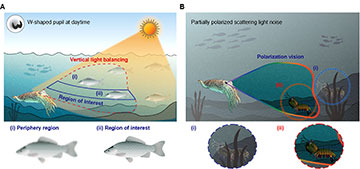Optical features of cuttlefish living in the underwater environment. [Image: Kim et al., Sci. Robot. 8, eade4698 (2023)] [Enlarge image]
The unique eyes of cuttlefish give the intelligent cephalopods high-contrast vision and the ability to recognize polarized light in the presence of uneven illumination and murky waters.
Now, researchers in the Republic of Korea have taken inspiration from cuttlefish eyes to create a new type of artificial vision system (Sci. Robot., doi: 10.1126/scirobotics.ade4698). The device mimics the marine animal’s W-shaped pupil and single spherical lens to enable better imaging for future applications such as autonomous vehicles and drones.
Inspired by the animal kingdom
Young Min Song, group leader of the Flexible OptoElectronics Laboratory at Gwangju Institute of Science Technology, and his colleagues previously developed an amphibious camera with panoramic vision inspired by the compound eyes of the fiddler crab. Based on the project’s success, the team kept looking for inspiration from the animal kingdom for novel approaches to conventional camera systems.
“While researching animal eyes, we discovered that cuttlefish can focus under harsh light conditions, like in shallow water, thanks to their unique W-shaped pupil and retina structure,” said Song. “This inspired us to create an artificial vision system that can also focus in challenging light environments.”
The ocular structure of the cuttlefish—consisting of a W-shaped pupil, a single spherical lens, and a curved retina with a high-density photoreceptor arrangement and polarized light sensitivity—is optimized for vertically uneven illumination conditions. To capture the same abilities, the researchers carefully mimicked the structure and function of each component to produce a working artificial cuttlefish eye.
Replicating cuttlefish features
Song and his colleagues recreated the W-shaped pupil, which serves to reduce the amount of sunlight entering the cephalopod’s eye, and found that it produced even lighting in the resulting images. In the artificial vision system, this feature compensated for the uneven light distribution by reducing incident light from the top of its vertical field of view.
Cuttlefish have a specialized region in their retina that has a high density of photoreceptor cells, which allows for high-resolution imaging in their main visual fields. The researchers mimicked this feature by adjusting the pixel density distribution of a cylindrical silicon photodiode array. The system also replicates the animal’s ability to recognize polarized light with a flexible carbon nanotube polarization film placed on top of the photodiode array.
“We confirmed each optical feature of the system through imaging tests,” said Song. “These tests demonstrated the W-shaped pupil's ability to balance light under uneven vertical illumination, the camera's polarization recognition by revealing hidden patterns with polarized light, and the high resolution of the densely packed photodiode array region in the resulting image.”
A future in self-driving cars
Song foresees such an artificial vision system being put to use in autonomous vehicles. For example, by incorporating the W-shaped pupil into the vehicle’s cameras, the issue of sun glare can be resolved without the need for additional post-processing. In addition, polarized light reflected from glazed surfaces on the road can be detected and used to improve the quality of the images.
“Our artificial cuttlefish vision system is unique because it is designed to excel in specific environments with uneven and polarized light illumination,” he said. “Additionally, it can capture higher resolution in regions of interest, which is beneficial for efficient image processing and data storage.”

